VISUALISERING AV RASESTANDARDEN FOR BEAGLE
The Beagle is a small scent hound, bred to track rabbit and hare as the hunter follows on foot. The Standard describes the required physical attributes and the point scale emphasizes the relative importance of these qualities needed to accomplish their task.
A good head allows for maximum function of the olfactory (sense of smell)system. Correct running gear is critical for endurance and speed, a good chest and strong back also ensure endurance. A Beagle’s neck must be supple and long enough for its nose to reach the ground comfortably. Well-boned legs provide sturdy support. Balance is important for efficient running and good feet necessary for rough terrain. Thin coats offer little protection against brambles and sharp brush, and a too gay tail cannot be seen over high groundcover.
General Appearance
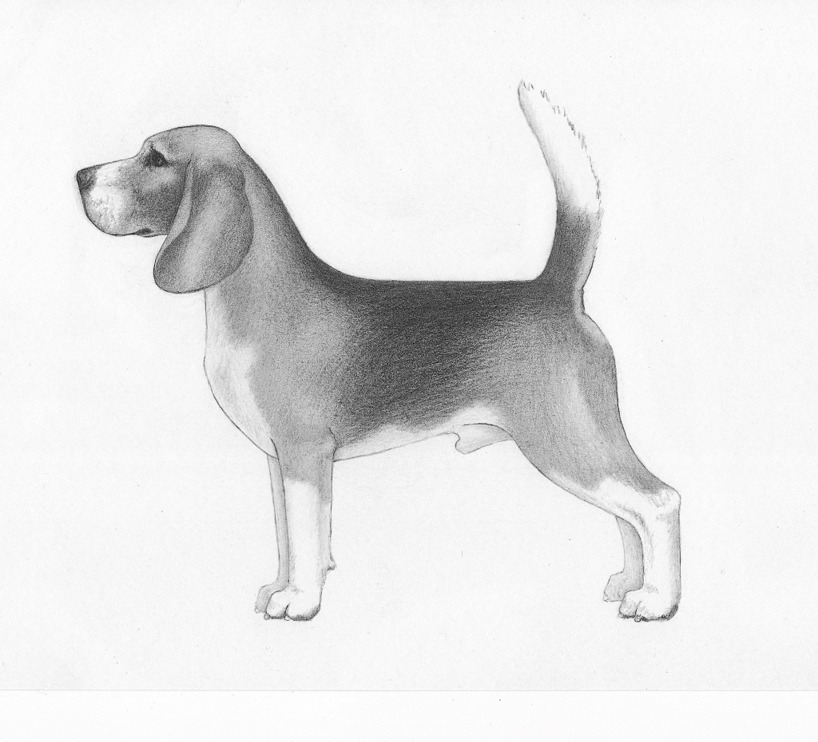
General Appearance:
A miniature Foxhound, solid and big for his inches, with the wear-and-tear look of the hound that can last in the chase and follow his quarry to the death.
The proper English Foxhound is a beautifully proportioned hound, elegant in style, balanced fore and aft and nicely boned. “Big for its inches” means plenty of bone (particularly the round bone of the forelegs) for the height of the hound. Too much bone results in coarseness, too little in a spindly look. There should be no suggestion of ‘toyishness”.
Temperament: This “Merry Little Hound” is just that: happy, friendly, and courageous without being foolhardy. As pack hounds, they must be good-natured and coexist and work with other dogs happily. Shy or mean Beagles are problem hounds and should not be tolerated. Bred for scenting game, the Beagle’s nose may move automatically to the ground when shown on a loose lead.
Presentation in the Ring: The Beagle is a working scent hound and should have a natural look. Excess hair may be trimmed from the neck and body, tidying the outline, but still maintaining a natural appearance, not appearing barbered or shaved. The long hairs at the tip of the tail are shaped to give a smoother natural appearance, ending in a properly rounded tip, not flattened or squared off, nor should the hair on the tail be teased and backcombed to resemble a bottle brush. Whiskers may be trimmed to give a clean line to the muzzle, but may also be left untrimmed. Whiskers serve as sensory organs, probably serving to protect the eye as the Beagle hunts in close brush. Dewclaws may be removed to give a clean line to the legs. Nails are kept trimmed to help maintain the compact foot. Clean teeth, clean coat with a natural healthy gloss enhance the appearance of any hound. Provided the coat is a true hound color, color and markings in the breed are of no consequence. Artificial enhancement to color of the coat, nose or eye rims, is prohibited by the American Kennel Club and is not to be tolerated.
Varieties/Disqualification
Varieties:
There shall be two varieties:
Thirteen Inch, which shall be for hounds not exceeding 13 inches in height.
Fifteen Inch, which shall be for hounds over 13 but not exceeding 15 inches in height.
Disqualification:
Any hound measuring more than 15 inches shall be disqualified.
Height is the only disqualification in the Beagle Standard and thus proper importance should be placed on it. The division into two sizes should be just that, the 13” should be a smaller replica of the 15”. And both should be smaller proportionate versions of the English Foxhound. The Beagle was always bred in a range of sizes in the United States due to the differences in terrain, groundcover and quarry, and the personal preference of the huntsman. When competing in field trials and pack meets, the smaller hounds were at a disadvantage and as a result, the two varieties were established to allow for a more level playing field when competing. In the ring there is no other preference to size, including variations of height within a variety.
The height of a Beagle can be very deceiving, dependent on shoulder placement. If a hound has poor shoulder angulation, it’s possible that the highest point over the shoulder blades could reach up into the neck. A Beagle with good shoulders can actually be a considerably overall larger hound and still measure within the limits of 13 or 15 inches. Judges are encouraged to measure as part of their routine examination of the Beagle.
Head 25%

The head accounts for 25% of the scale of points in the Beagle Standard, and while it is a hallmark of the breed, the Beagle is by no means a “head breed”. The head is important and should be carefully studied to understand correct construction. But, do not judge the Beagle as a “head breed”, recognize a correct head, but place importance to the functional portion of the hound, the body.

Head – Skull & Muzzle

Skull 5%: The skull should be fairly long, slightly domed at occiput, with cranium broad and full.
While the planes of the top skull and muzzle should be parallel, the top skull is not flat, it rounds gently to the occiput. The length of skull from occiput to stop should be approximately equal to the length of muzzle from stop to tip of nose. The stop should be moderate with no indication of ‘dishiness’ as in a Pointer or Cocker head.

Although not specifically mentioned in the standard, most breeders agree that the head should be free from wrinkle, as a wrinkled head can create a “worried” and unappealing expression.
Muzzle 5%: Muzzle of medium length-straight and square cut, the stop moderately defined. Jaws: Level. Lips free from flews, nostrils large and open.

The muzzle should be full and somewhat rounded with good depth, not flat or chiseled under the eye. A short muzzle is undesirable, giving the Beagle a ‘toyish’ appearance and decreasing the area for olfactory capabilities. Large, open nostrils are critical for scenting capabilities. The nose pigment should fit the color of the hound. In the black tri-colored Beagle, the nose should be black. In lemon/white, red/white or other colors, a lighter pigment is acceptable, in general however, the darker the pigment, the better.
There is no specific mention of the bite in the Beagle Standard, but the English Foxhound Standard calls specifically for teeth which meet squarely, neither overshot nor undershot. The level jaw asked for in the Beagle Standard indicates that a scissors bite is preferred in the Beagle, but a level bite is acceptable. An occasional skewed or missing tooth is not to be penalized..
Head – Ears & Eyes, Defects
Ears 10%: Ears set on moderately low, long, reaching when drawn out nearly, if not quite, to the end of the nose; fine in texture, fairly broad-with almost entire absence of erectile power-setting close to the head, with the forward edge slightly inturning to the cheek, rounded at tip.
The ears should be set on level with the outer corner of the eye. Ear length is important for gathering scent in the field. While nearly lacking erectile power, the base will rise a bit when excited, but not above the level of the topskull.

Eyes 5%: Eyes large, set well apart-soft and houndlike, expression gentle and pleading, of a brown or hazel color.
The shape of the eye should be round to almond, always soft and expressive. Color of the Beagle’s eyes should fit the coloration of the hound, but preferably darker rather than lighter. While pigmented eye rims are necessary to achieve a “soft” expression, an abundance of black pigmentation, “mascara”, is not. A “gentle, pleading expression” is a factor of a correct eye shape and size, combined with a generally darker eye color. A smaller eye is to be penalized, as are yellow or blue eyes as they give an improper expression.
Head Defects: A very flat skull, narrow across the top; excess of dome, eyes small, sharp and terrierlike, or prominent and protruding; muzzle long, snipy or cut away decidedly below the eyes, or very short. Roman-nosed, or upturned, giving a dish-face expression. Ears short, set on high or with a tendency to rise above the point of origin.
Body 35%
Balance is critical. The length of body measured from prosternum to point of buttock is longer than distance from withers to ground. There should be prosternum visible in front of the shoulder. Additionally, there should be some “dog behind the tail”, which is created by proper angulation of the pelvis as it meets the femur. As a result, the beagle is off square, longer than tall.
Although the standard calls for a short back, the back must have sufficient length to allow for proper rib construction and a well muscled loin. Ribs should extend well back. Back length should be long enough to allow for a ground covering side gait; hounds that are too short coupled will not be able to accommodate the angulation necessary for endurance in the field. A shorter backed beagle is not necessarily more correct.

Body – Neck & Throat 5%
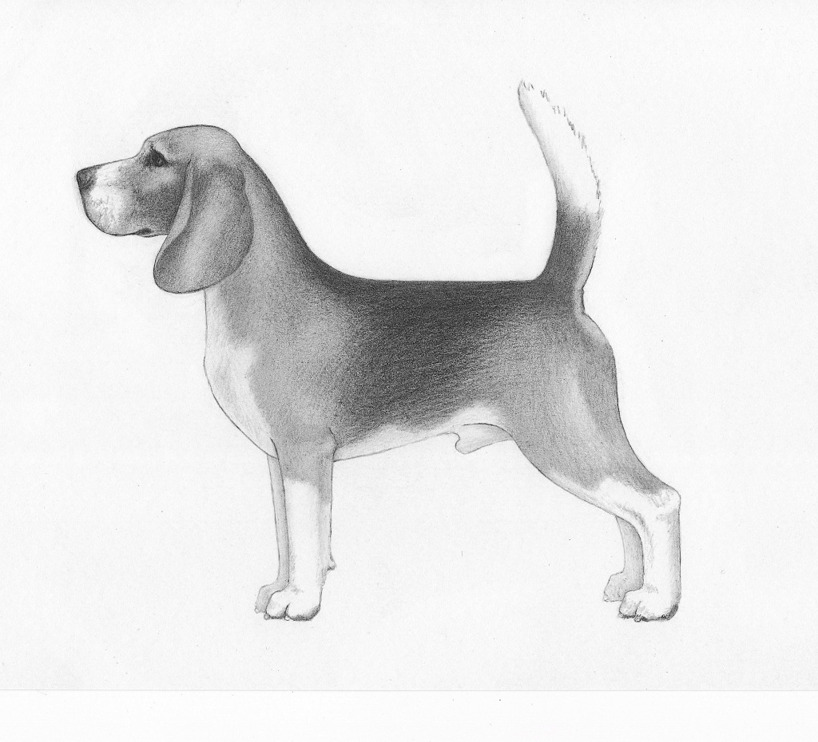
Neck and Throat 5%: Neck rising free and light from the shoulders strong in substance yet not loaded, of medium length. The throat clean and free from folds of skin; a slight wrinkle below the angle of the jaw, however, may be allowable. Defects: A thick, short, cloddy neck carried on a line with the top of the shoulders. Throat showing dewlap and folds of skin to a degree termed “throatiness.”
The neck must be long and pliable enough for the nose to reach the ground for tracking without forcing the dog to crouch. There should be a slight arch from where the neck meets the occiput and extends down, blending smoothly into the shoulders.
Body – Shoulders & Chest 15%
Shoulders and Chest 15%: Shoulders sloping–clean, muscular, not heavy or loaded–conveying the idea of freedom of action with activity and strength. Chest deep and broad, but not broad enough to interfere with the free play of the shoulders. Defects: Straight, upright shoulders. Chest disproportionately wide or with lack of depth..

There should be forechest visible in front of the shoulders and front legs, allowing for sufficient lung/heart capacity and layback of shoulder. The end of the sternum should be behind the front legs and the brisket should reach at least to, or preferably a bit below, the point of the elbow. The distance between withers and ground is equally divided by elbow and depth of chest.
In the correct shoulder assembly, a line dropped from the tip of the scapula to the ground will fall through the front leg. The length of the scapula should be equal to the length of the humerus.
Body – Back, Loin and Ribs 15%
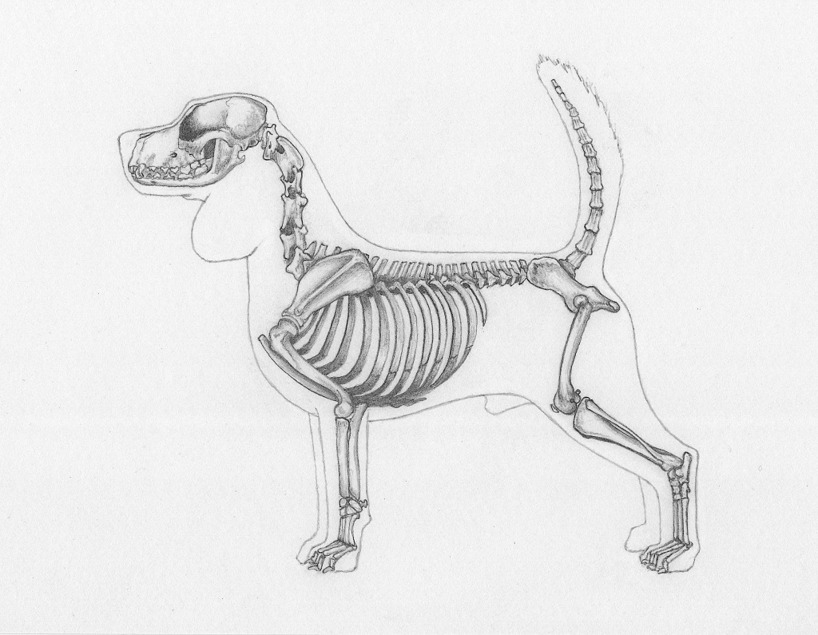
Back, Loin and Ribs 15%:
Back short, muscular and strong. Loin broad and slightly arched, and the ribs well sprung, giving abundance of lung room. Defects: Very long or swayed or roached back. Flat, narrow loin. Flat ribs.
The ribs should extend well back, 2/3 of the distance from the withers to the point of hip should be ribbing, the remaining 1/3, the loin. The ribs should spring wide from the spine gradually rounded off as they reach the brisket. Viewed in profile, the Beagle should have a slight tuck-up with a gradual rise in the underline from where it becomes visible behind the front leg to where it disappears behind the rear leg.
The topline should be level. The “slightly arched” loin does not mean a roach or curve resulting in a low tail set. Muscle development along either side of the spine gives the loin a slightly arched look when viewed from above, the front or behind, but not in profile. Viewed from above, the shoulders/chest and the pelvis should be of equal width.

Running Gear 35%
Forelegs 10%: Straight, with plenty of bone in proportion to size of the hound. Pasterns short and straight. Defects: Out at elbows. Knees knuckled over forward, or bent backward. Forelegs crooked or Dachshund-like.
Note the requirement of “plenty of bone in proportion to the size of the hound”. A larger circumference of bone will allow for a greater mass of muscle attachment, adding to the endurance of the hound. Too much bone, makes for extra work for the dog and is undesirable. Bone should be round. Pasterns should be straight but flexible, sloping pasterns break down in the field.

Hips, Thighs & Hind Legs 10%: Hips and thighs strong and well muscled, giving abundance of propelling power. Stifles strong and well let down. Hocks firm, symmetrical and moderately bent. Feet close and firm. Defects–Cowhocks, or straight hocks. Lack of muscle and propelling power. Open feet.
Stifles strong and well let down implies a long femur (upper bone of the hind leg) with moderate angulation at the knee and hock joints. A line drawn down from the point of the buttock will fall to the front of the hind foot.
Running Gear – Feet 10%

Feet 10%: Close, round and firm. Pad full and hard. Defects: Feet long, open or spreading.
Feet account for 10 points, emphasizing their importance. A firm cat foot with hard, full pads allows the Beagle to hunt for hours over difficult terrain. Bent pasterns, flat spreading feet or long feet are ineffective supports for a working hound. Occasionally a foot with an exceptionally short outer toe is seen, nearly always on the front legs. An x-ray of the foot reveals a short metatarsal bone for that toe. This does not conform to the required cat foot and is generally found on feet which are otherwise quite tight and firm. A short toe is to be penalized, as it does not allow for a complete foot on the ground, resulting in an ineffective support for balance or turning.
Gait
Though not specifically mentioned in the standard, proper movement is implied by the description of the running gear, shoulder and rear construction. The Beagle works in the field at a walk, trot and gallop. While hunting the scent of the rabbit, the Beagle trots with nose to the ground, circling, nosing under brush. Once the trail is found, the beagle signals with his full-voiced cry and off he goes in hot pursuit. Hours of hunting may be required.
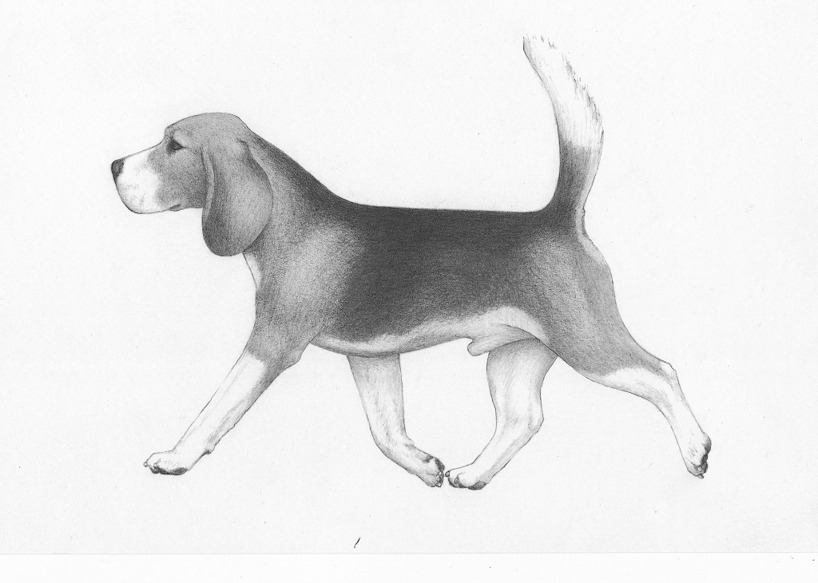
In the conformation ring, the Beagle should be viewed from the side, front and rear while moving at a moderate trot. There should be good reach of the front legs and good drive from the rear when viewed from the side, movement should be effortless. On a Beagle with good reach and drive, the front leg extends straight out at approximately a 45 degree angle with the toes extending to a vertical line drawn down from the tip of the nose. The rear leg is 45 degrees the opposite direction. When viewed from the side the topline should remain fairly level when the Beagle is moving properly.
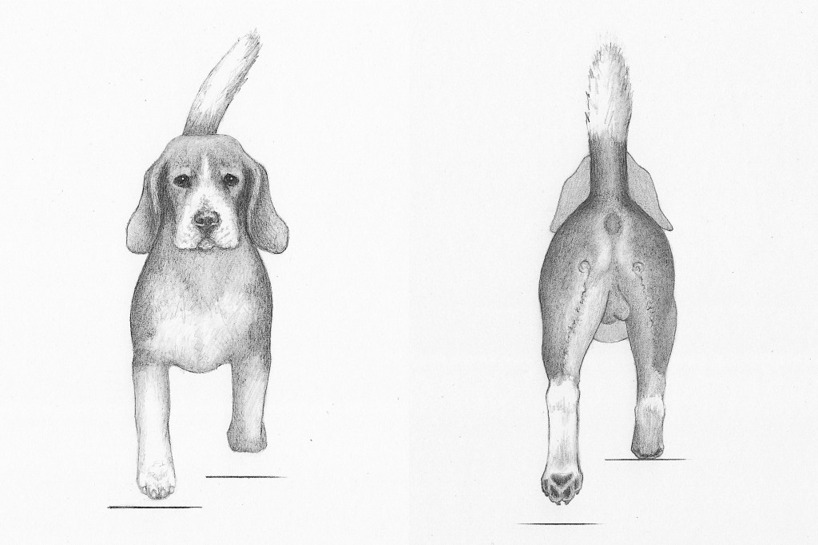
From the front, the forelegs should move straight forward, with the hind legs following in the footsteps of the front. From the rear, the hocks should move perpendicularly to the ground, neither too wide nor too close. The Beagle double tracks at a moderate trot, meaning the front and rear legs remain parallel with each other. As the speed of the Beagle increases, the legs will continue to move in the same planes, and only a slight inclination to single track will occur.
Paddling, elbows out, high-stepping gait, hocks turning in or out, pounding, close approximation of the hind feet, single tracking, lack of reach and/or drive or skipping are all examples of faulty movement and indicate improper structure.
Tail 5%
Tail 5%: Set moderately high; carried gaily, but not turned forward over the back; with slight curve; short as compared with size of the hound; with brush. Defects: A long tail. Teapot curve or inclined forward from the root. Rat tail with absence of brush.
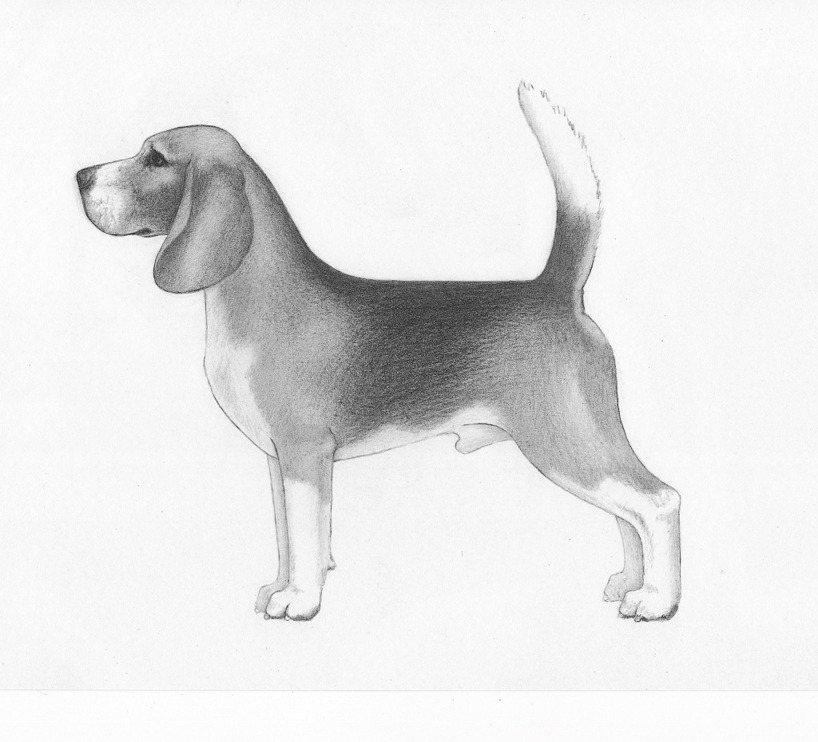
The tip of the tail should be slightly higher than the head when held at attention. Carriage is perpendicular to the topline and may have a slight curve, never to be inclined forward from the root or carried over or touching the back, as this does not enable the beagle to be followed in the field. Although a white tip serves as a “flag” to reveal his whereabouts in the field, an absence of a white tip is not to be penalized. While adequate brush on the tail is necessary to protect the tail from damage while hunting, more brush is not necessarily better. The tail should be carried upright while gaiting but should never be penalized should it drop when the dog stops.
Coat 5%
Coat 5%:
A close, hard, hound coat of medium length. Defects: A short, thin coat, or of a soft quality. Color: Any true hound color.
A coat as described in the standard provides protection from brush and brambles, a requirement for a hunting hound. “Any true hound color” includes traditional black/tan/white tri, or blue tri. The tri-colored Beagle can be either richly and deeply colored or faded (the blanket containing more tan than black or blue hairs). Other, equally acceptable colors, are tan/white, lemon/white, red/white & chocolate, as well as variations and dilutes of these colors. While ticking on a Beagle is fine, grizzle or brindling are not acceptable.
Markings can add or detract from the overall appearance of the Beagle. The quality of the hound, not the arrangement of color, is the important matter. Markings can sometimes create optical illusions when evaluating a Beagle but should not be allowed to distract from the actual conformation or movement.
The words “Any true hound color” in the Beagle standard cannot be emphasized enough. Any artificial enhancement of coat color is to be penalized.
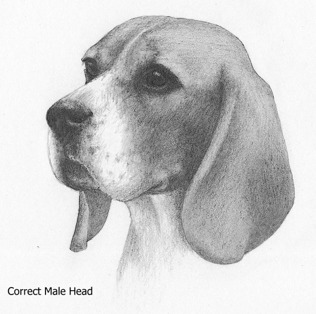
Kilde: Visualizations of the beagle standard er utarbeidet av National Beagle Club Inc, USA. Dokumentet finner du HER









